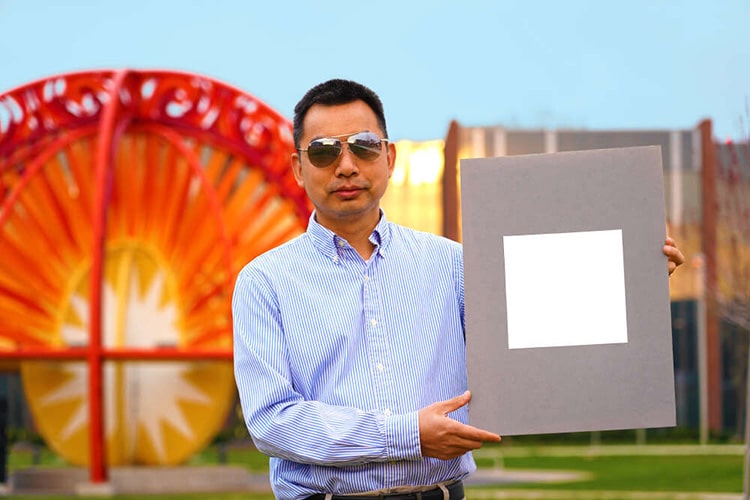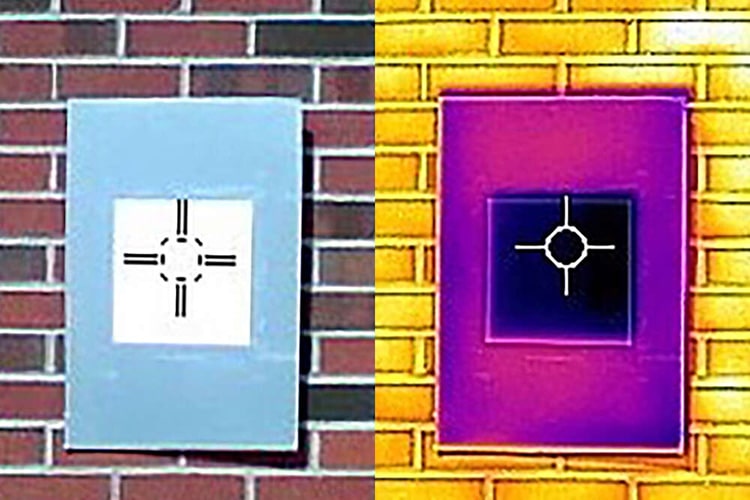
Professor Xiulin Ruan with a sample of the whitest paint yet developed. (Photo: Jared Pike/Purdue University)
Combatting the rise in global temperatures requires creative science and innovative thinking. An exciting, new development was recently announced in the journal ACS Applied Materials & Interfaces by an engineering and nanotechnology team at Purdue University. The team created an ultra-white paint—the whitest to date—which promises a powerful cooling effect that could help combat the use of air conditioning units which contribute to climate change.
Scientists had previously discovered a white paint that reflects 95.5% of light. This paint was based on calcium carbonate (CaCO3), which is found in chalk. While the darkest black (vantablack) absorbs 99.95% of light waves, the brightest white should reflect the maximum light possible. The announcement of a new formula for ultra-white is another step in this quest. Based on a high concentration of the pigment barium sulphate, the new paint reflects 98.1% of sunlight. Barium sulphate also reflects UV light. As a result, the paint bounces light and heat right back to deep space in the form of radiation (waves) which travel through our atmosphere without being absorbed.
The material properties of this new ultra-white paint achieved an 8-degree (Fahrenheit) cooling effect in direct sunlight, and a nighttime effect of a whopping 19 degrees. A 1,000-square-foot roof coated in the new paint would cool with a power of 10 kilowatts. According to Professor Xiulin Ruan, one of the authors of the study, “That’s more powerful than the central air conditioners used by most houses.” While white paint's cooling effect has long been known and used in architecture, this more efficient ultra-white paint could substantially reduce energy use (and therefore emissions) by strategic use in both cities and rural areas.
When will you be able to pick up a few gallons and paint the house? Hopefully within a few years, if the Purdue team has anything to say about it. The team and the university have filed for a patent for the paint and hope to work with industrial partners to bring it to market. Barium sulphate is cheaper than traditional paint pigments, and the process to create the ultra-white paint is quite similar. However, there are some areas to continue developing—such as how to make the paint cost-effective given the layers required to achieve the ultra-white.
Professor Ruan told IFLScience, “According to a previous model, painting 0.5-1% of the Earth's surface (roofs, roads, cars, unused land, etc) with our paint will stop the warming trend.” While the logistical hurdles must be taken in stride, solutions such as ultra-white paint which could help stave off the continual warming of the planet must be considered. For those who are concerned about such a reflective surface, the team assures everyone that the white paint's reflective properties do not hurt your eyes—it will just be a bit whiter than snow to the human eye.
A research team at Purdue University has created an ultra-white paint—the whitest created so far—which offers impressive reflective and cooling powers. These properties could aid the fight against climate change.

Infrared images showing how the ultrawhite paint actually has a cooling effect. The purple is ambient temperature, the black represents the cooler painted swatch. (Photo: Joseph Peoples/Purdue University)
h/t: [The Guardian, IFL Science]
Related Articles:
Cuttlefish Have Passed the “Marshmallow Test” Originally Designed for Human Children
NASA Releases Breathtaking Image of Rolling Blue Dunes on Mars
High School Senior Creates Color Changing Surgical Sutures That Alert Infection
World’s Oldest DNA Is Discovered in a 1.2-Million-Year-Old Mammoth






















































































